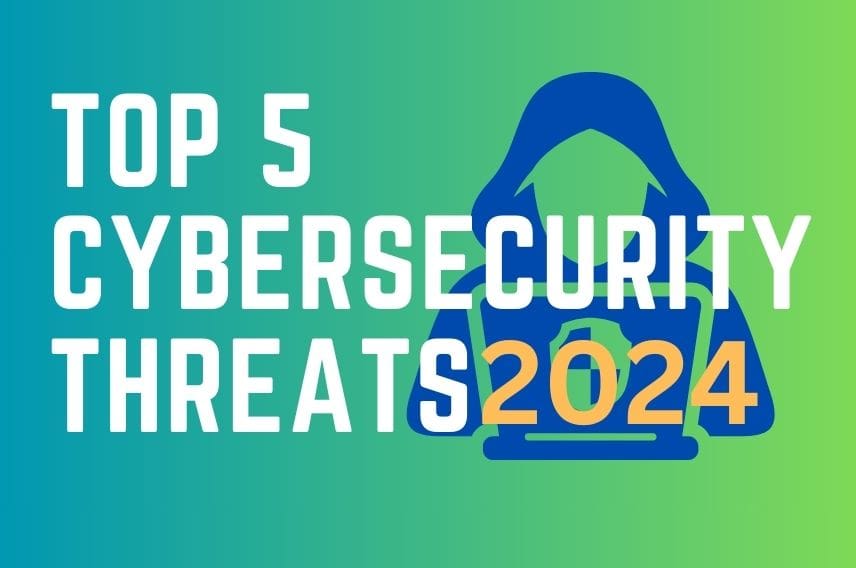In today’s digital age, cybersecurity threats are constantly evolving and becoming increasingly sophisticated. Businesses of all sizes are at risk, and it’s crucial to stay ahead of the curve by understanding the latest threats and taking proactive steps to protect your data and systems.
Here are the top 5 cybersecurity threats your business should be prepared for in 2024:
1. Ransomware-as-a-Service (RaaS): A Growing Threat for Businesses
RaaS has become a major concern for businesses of all sizes, offering a “one-stop shop” for aspiring cybercriminals. These platforms provide readily available tools and infrastructure to launch ransomware attacks, lowering the technical barrier and making it accessible even for those with limited expertise.
Impact:
- Data encryption and operational disruptions, leading to significant financial losses and downtime.
- Reputational damage due to data breaches and public exposure.
- Regulatory compliance issues and potential fines, depending on the industry and data involved.
Recommendations:
- Implement robust data backups and recovery solutions to ensure business continuity.
- Regularly update software and systems to patch vulnerabilities before attackers exploit them.
- Conduct security awareness training for employees, fostering vigilance against phishing attempts.
- Consider cyber insurance to mitigate financial losses in case of an attack.
2. AI and Machine Learning: Fueling the Evolution of Cyberattacks
AI and ML are quickly becoming invaluable tools in the hands of cybercriminals, enabling them to:
- Automate tasks: Repetitive tasks like reconnaissance and vulnerability scanning can be automated, increasing attack efficiency and speed.
- Personalize attacks: AI can analyze vast amounts of data to tailor attacks to specific targets, increasing their success rate.
- Evade detection: Machine learning algorithms can be used to develop sophisticated malware that can bypass traditional security defenses.
Impact:
- Increased frequency and sophistication of cyberattacks, making them harder to detect and prevent.
- More targeted attacks that exploit specific vulnerabilities within your organization.
- Potential for widespread damage due to the automation and scalability of AI-driven attacks.
Recommendations:
- Implement AI-powered security solutions to counter the evolving threat landscape.
- Utilize behavioral analytics and anomaly detection systems to identify suspicious activity.
- Continuously monitor and update security controls to adapt to new threats and vulnerabilities.
- Stay informed about emerging AI-based threats and research best practices for mitigation.
3. Vulnerabilities in Supply Chains: A Hidden Threat
Supply chain attacks target vulnerabilities in third-party vendors that provide critical services or products to your organization. Gaining access through a vendor can give attackers a foothold to infiltrate your network and access sensitive data.
Impact:
- Data breaches compromising your organization’s sensitive information and customer data.
- Operational disruptions due to compromised systems and infrastructure.
- Loss of trust and reputational damage due to supply chain breaches.
Recommendations:
- Conduct thorough security audits of your vendors before entering into agreements.
- Require vendors to implement strong security measures and maintain transparency in their practices.
- Implement secure communication channels and data encryption protocols for vendor interaction.
- Monitor vendor activity for anomalies and suspicious behavior to detect potential breaches early.
4. Targeting Critical Infrastructure: A Threat to National Security
Critical infrastructure, such as power grids, transportation systems, and financial institutions, are increasingly being targeted by cyberattacks due to their potential for widespread disruption.
Impact:
- Widespread outages and disruptions to essential services, impacting millions of people.
- Economic damage and financial losses due to infrastructure downtime.
- Potential for national security threats and destabilization.
Recommendations:
- Government and private sector collaboration to enhance critical infrastructure security.
- Investments in robust cyber defense systems and incident response capabilities.
- Implementation of stricter regulations and compliance requirements for critical infrastructure providers.
- Public awareness campaigns to educate citizens about the threats and mitigation strategies.
5. Diverse IoT Ecosystem: A Growing Attack Surface
The ever-expanding Internet of Things (IoT) introduces a vast new attack surface for cybercriminals. The diverse range of devices, often with limited security measures, presents numerous vulnerabilities for attackers to exploit.
Impact:
- Botnet attacks leveraging compromised IoT devices to launch large-scale DDoS attacks.
- Data breaches exposing personal information and sensitive data collected by IoT devices.
- Physical damage and safety risks in the case of connected devices controlling critical systems.
Recommendations:
- Implement strong authentication and access control mechanisms for IoT devices.
- Regularly update firmware and software for all connected devices to patch vulnerabilities.
- Segment your network to isolate IoT devices from critical systems and sensitive data.
- Monitor IoT activity for anomalies and suspicious behavior to detect potential compromises.
By understanding the specific threats each of these categories presents and implementing proactive mitigation strategies, businesses can significantly enhance their cybersecurity posture and protect themselves against the evolving landscape of cyberattacks.
Additional Resources:
- The Cybersecurity & Infrastructure Security Agency (CISA): https://www.cisa.gov/
- The National Institute of Standards and Technology (NIST): https://www.nist.gov/cyberframework
